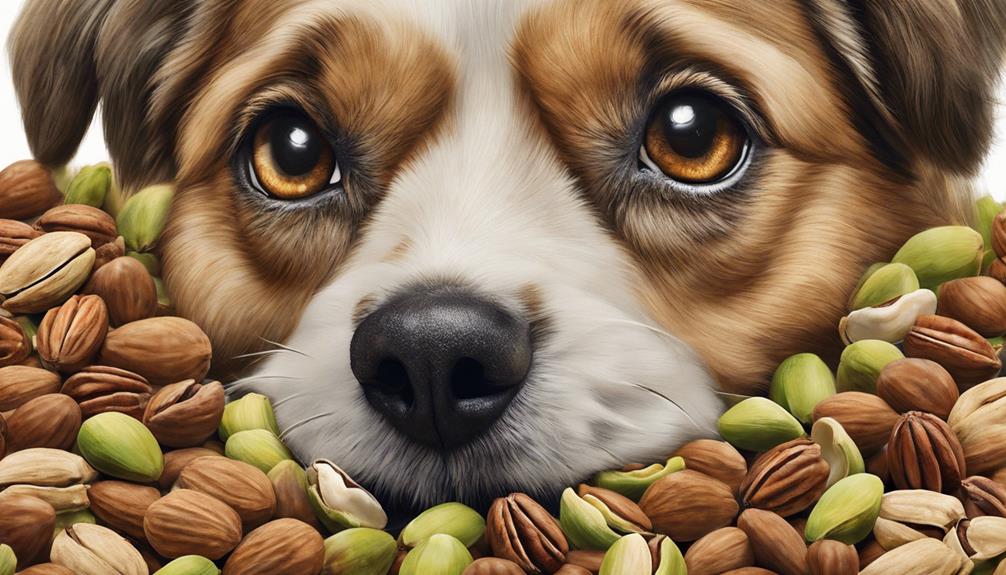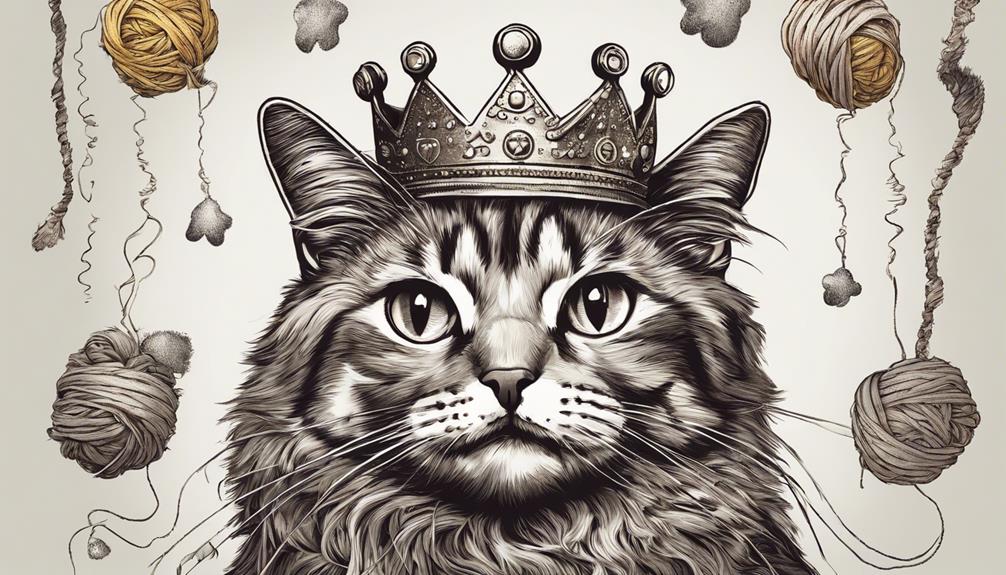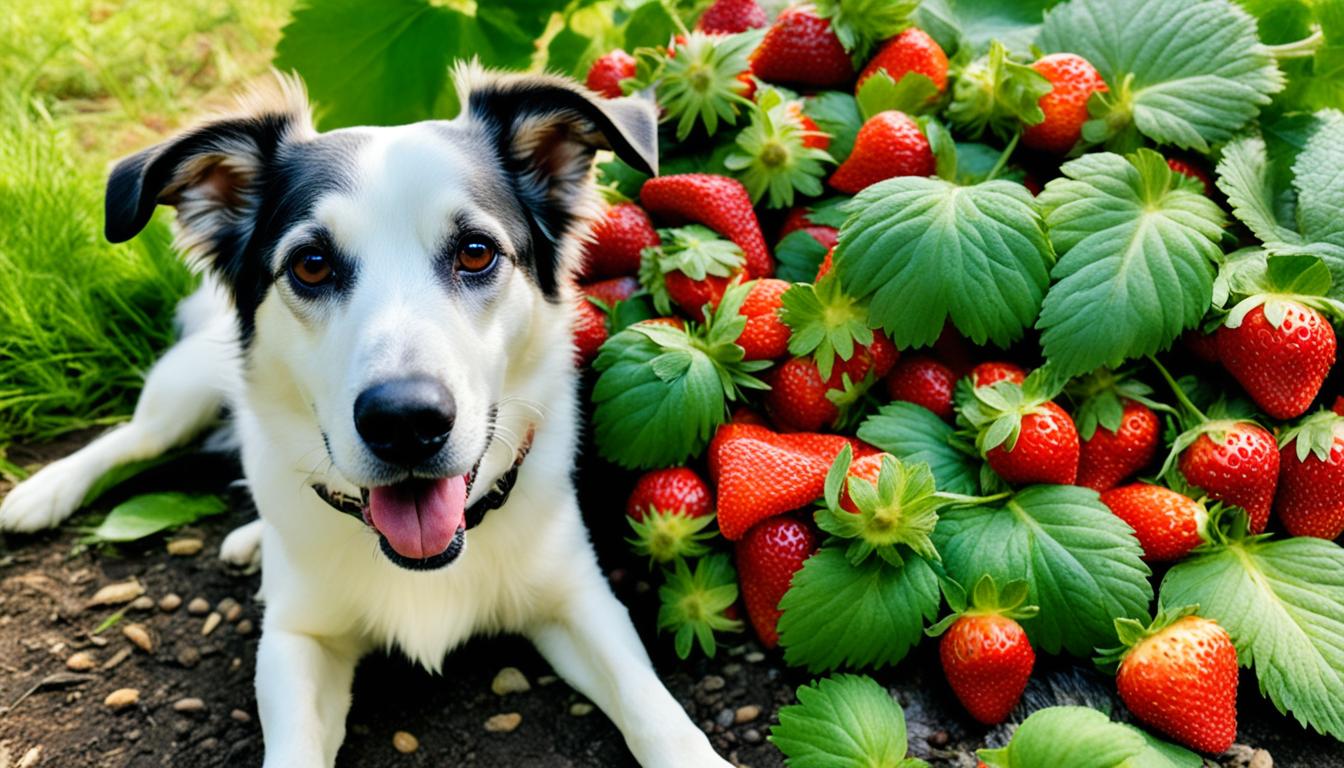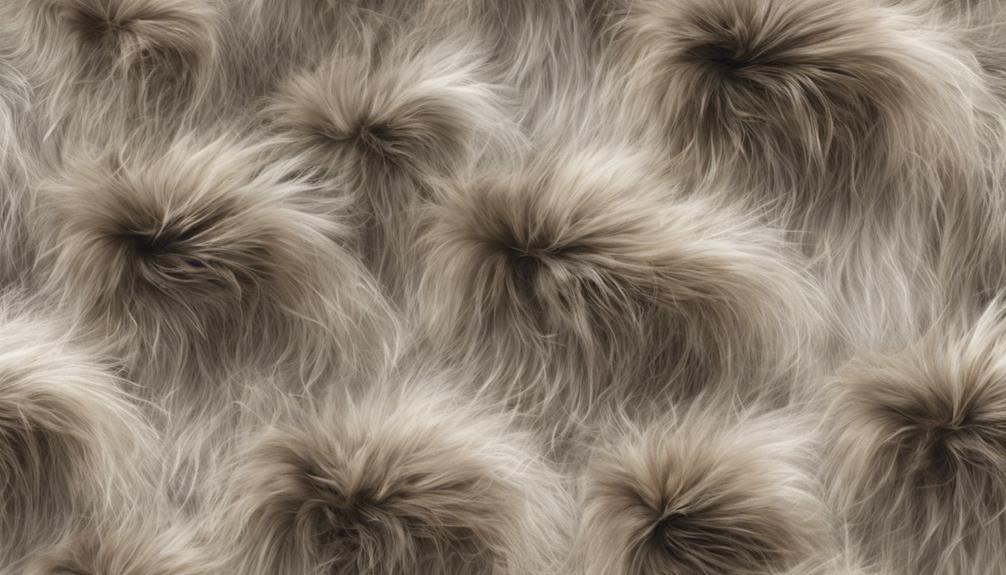Dogs shouldn't have pistachios since they can be risky. Pistachios could cause choking or have toxic substances harmful to dogs. Shells may be a choking hazard, leading to blockages. High fat content might trigger pancreatitis or upset stomachs. Aflatoxin can make dogs weak or sick with upset stomachs. To avoid problems, skip offering pistachios to dogs. Always pick safer treats. If a dog eats pistachios, contact a vet immediately. Look for symptoms like vomiting or tiredness. There's more to learn about the dangers of pistachios for dogs.
Key Takeaways
- Dogs should not have pistachios due to choking hazards, toxicity risks, and potential pancreatitis.
- Pistachios can cause choking, blockages, and gastrointestinal upset in dogs.
- Toxic components like aflatoxin and urushiol in pistachios can harm dogs.
- Consult a vet if a dog ingests pistachios to prevent health complications.
- Opt for safer treat options and avoid pistachios to safeguard your dog's well-being.
Pistachios: Dog-Friendly Nutritional Benefits
Pistachios offer essential minerals like iron, magnesium, and potassium, which are beneficial for the overall health of dogs. These nutrients play a crucial role in maintaining a dog's well-being by supporting functions such as muscle strength, nerve function, and hydration.
Additionally, the antioxidants present in pistachios can help boost a dog's immune system, protecting them from various illnesses and promoting longevity. Dogs eating pistachios can also benefit from the fiber content in these nuts, aiding in digestion and promoting a healthy gut.
Vitamins A, C, and B6 found in pistachios are essential for a dog's growth, vision, and overall vitality. Dogs can enjoy the occasional treat of 2-3 unsalted pistachios as a nutritious snack that not only satisfies their taste buds but also provides valuable nutrients for their overall health.
Potential Risks of Feeding Pistachios to Dogs
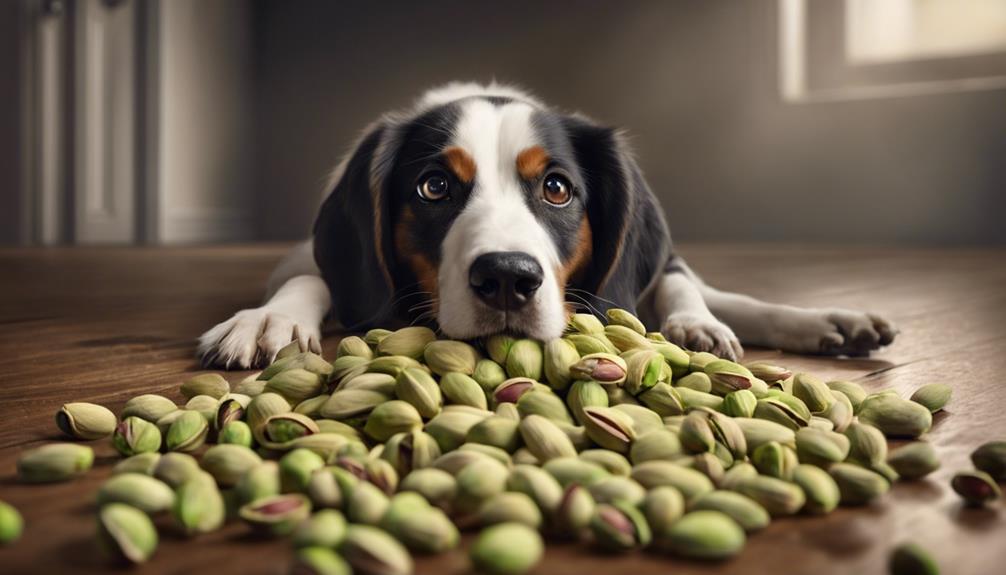
Pistachios pose risks to dogs such as choking hazards from swallowing nuts and shells, as well as potential toxicity concerns due to substances like aflatoxin and urushiol. These risks can lead to serious health issues like upset stomachs and pancreatitis in dogs.
It's important to prioritize our furry friends' well-being by refraining from feeding them pistachios to prevent any harm or discomfort.
Dog Choking Hazard
When considering feeding dogs pistachios, it's important to be aware of the potential choking hazard they pose. Pistachios, if swallowed whole or in pieces, can lead to choking incidents in dogs. Symptoms may include coughing, panic, or even unresponsiveness. Properly disposing of pistachio shells is vital to prevent such choking hazards.
Additionally, ingesting pistachios can also result in intestinal blockages for dogs, manifesting as symptoms like vomiting and abdominal pain. If your dog shows signs of choking or blockage after consuming pistachios, it's crucial to contact a vet immediately. Remember, pistachios can be harmful for dogs due to the risk of choking and intestinal blockages they present.
Toxicity Concerns
Considering the potential risks of feeding pistachios to dogs, it's important to be aware of the toxicity concerns associated with these nuts. Pistachios are high in fat, which can lead to pancreatitis in dogs. Additionally, the salt content in pistachios may cause gastrointestinal issues for our furry friends.
Additionally, there's a risk of aflatoxin exposure from mold on pistachios, which can make dogs weak and lethargic, as well as result in gastrointestinal upset. To prevent these dangers, it's vital to avoid feeding pistachios to dogs altogether.
Keeping our canine companions safe and healthy means being cautious about the toxins produced by pistachios and opting for safer treat options.
Choking Hazard From Pistachio Shells

As dog owners, we must be mindful of the potential choking hazard posed by pistachio shells if our pets ingest them. Pistachio shells can cause choking hazards for dogs if swallowed, leading to distressing situations where dogs may panic, cough, or become unresponsive.
In addition, ingesting pistachio shells can result in intestinal blockages in dogs, a serious condition that requires immediate veterinary attention. Symptoms of blockages include vomiting, abdominal pain, and lethargy, indicating a potentially life-threatening situation for our furry friends.
It's important to monitor our dogs when they're around pistachios and make sure that they don't have access to the shells to prevent such incidents. If your dog shows any signs of choking or blockage from pistachio shells, it's essential to contact a vet promptly for proper evaluation and treatment.
Keeping pistachio shells out of reach and staying vigilant can help safeguard our dogs from these choking hazards and potential blockages.
Pancreatitis Concerns and Pistachios

To prevent pancreatitis in dogs, it's important to be aware of the high fat content in pistachios. Pancreatitis concerns arise due to the potential triggering effect of this high fat content.
Symptoms of pancreatitis in dogs include diarrhea, vomiting, and loss of appetite. It's essential to understand these signs as they indicate a serious condition that necessitates immediate veterinary attention.
Dogs shouldn't consume pistachios to reduce the risk of pancreatitis development. If your furry friend shows signs of lethargy or gastrointestinal upset after ingesting pistachios, consulting a vet is imperative.
Understanding Toxic Components in Pistachios
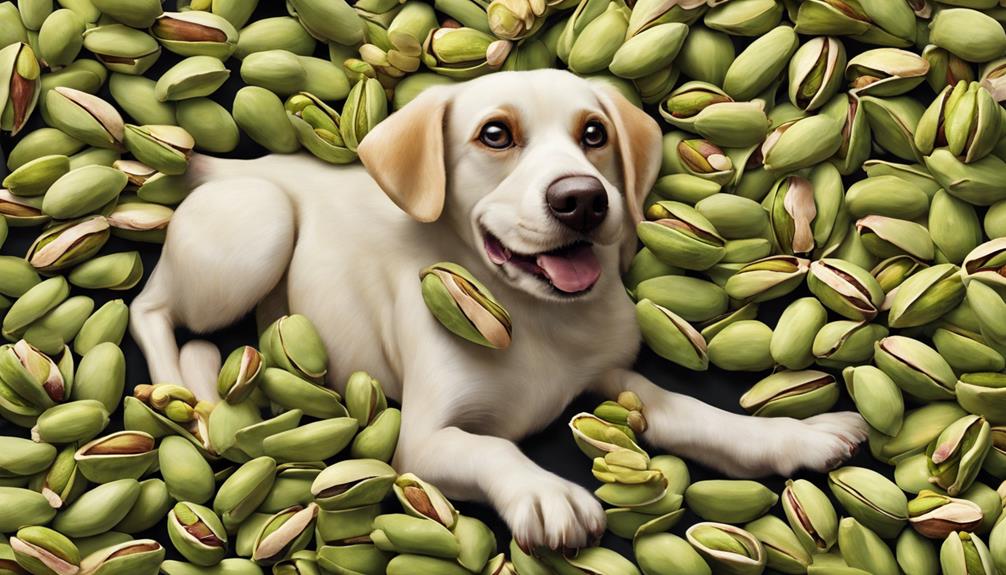
Pistachios pose a potential threat to dogs due to the presence of toxic components such as urushiol and aflatoxin. Urushiol in pistachios can cause allergy-like responses in dogs, while Aspergillus mold on the shells can produce aflatoxin, which is toxic to dogs.
Aflatoxin poisoning can lead to symptoms like weakness, lethargy, seizures, gastrointestinal upset, vomiting, and jaundice in dogs. It's important to understand that these components in pistachios can be harmful to our canine friends, and ingesting even small amounts can have serious consequences.
To keep our dogs safe and healthy, it's vital to prevent them from accessing pistachios or any products containing them. Being aware of the potential dangers of toxic components in pistachios can help us make informed decisions about what foods are safe for our furry companions.
Managing Pistachio Consumption for Dogs

Monitoring your dog's pistachio intake is essential for their overall health and well-being. When it comes to managing pistachio consumption for dogs, here are some key points to keep in mind:
- Limit Intake: Dogs should only have pistachios in moderation to prevent potential health issues.
- Avoid Shells: Refrain from giving dogs pistachio shells to steer clear of choking hazards and blockages.
- Watch for Symptoms: Be vigilant for signs of aflatoxin poisoning if your dog consumes pistachios.
- Seek Veterinary Care: If your dog displays symptoms like vomiting or lethargy after eating pistachios, contact your vet promptly.
- Consult a Professional: Always check with your veterinarian before including pistachios in your dog's diet, especially in large amounts.
Emergency: Dog Ate Pistachios, Now What?

If your dog ate pistachios, watch for signs like vomiting, diarrhea, or tiredness. Contact your vet or an emergency clinic right away if your dog consumed a lot of pistachios.
Large amounts of pistachios can cause severe illness in dogs, so prompt medical attention is essential.
Symptoms of Pistachio Toxicity
Experiencing symptoms of pistachio toxicity in dogs requires immediate veterinary attention to address potential life-threatening complications. When a dog shows signs of pistachio poisoning, look out for:
- Loss of appetite
- Vomiting
- Orange-colored urine
- Lethargy
- Jaundice
Urushiol found in pistachios can trigger allergic reactions in dogs, leading to itching, redness, and swelling. Additionally, aflatoxin poisoning from mold on pistachios can result in serious health issues like seizures and gastrointestinal upset.
Recognizing these symptoms early and seeking prompt veterinary care is essential to prevent the condition from worsening. Remember, swift action can make a significant difference in your dog's recovery from pistachio toxicity.
Immediate Veterinary Attention
Recognizing the urgency of the situation, immediate veterinary attention is essential if your dog has ingested pistachios. Large quantities of pistachios can make dogs very sick, leading to symptoms like vomiting, lethargy, or abdominal pain. In such cases, contacting a vet or an emergency clinic is imperative. Quick medical intervention is necessary to address any potential issues that may arise from your dog eating pistachios. To highlight the importance of seeking help promptly, here is a table summarizing the steps to take if your dog ingests pistachios:
| Immediate Actions | Description | Importance |
|---|---|---|
| Call Vet | Contact a veterinarian | Vital |
| Monitor Symptoms | Watch for signs of illness | Critical |
| Avoid Home Remedies | Don't try treatments at home | Important |
Potential Health Complications
In cases where a dog has consumed pistachios, potential health complications may arise, necessitating prompt veterinary attention. Here are some reasons why pistachios can be harmful to dogs:
- Gastrointestinal Upset: Eating pistachios can lead to vomiting and diarrhea in dogs due to their high fat content.
- Choking Hazards: Dogs might choke on pistachio nuts or shells, causing blockages or respiratory problems.
- Aflatoxin Exposure: Mold on pistachio shells can contain aflatoxin, making dogs weak, lethargic, and prone to seizures if ingested in large amounts.
- Pancreatitis Risk: The fat in pistachios can trigger pancreatitis in dogs, showing symptoms like loss of appetite and vomiting.
- Dietary Fiber Concerns: The dietary fiber in pistachios can also contribute to gastrointestinal issues in dogs.
Comparing Pistachios to Other Dangerous Nuts

Comparing the potential risks of pistachios to those posed by macadamia nuts, black walnuts, and pecans reveals the importance of understanding which nuts are safe for dogs to consume. While pistachios are generally safe for dogs overall, macadamia nuts, black walnuts, and pecans can be harmful due to toxins they contain.
Macadamia nuts can cause weakness, vomiting, and hyperthermia in dogs. Black walnuts, commonly found in poison ivy, can lead to gastrointestinal distress and neurological problems. Pecans are known to cause tremors and seizures in dogs. Unlike pistachios, these nuts should be avoided to prevent health issues.
It's critical to consult a veterinarian before giving any new nuts to your furry friend. Monitoring for signs of intolerance or allergies post-consumption is essential for your pet's well-being. By understanding the risks associated with different nuts, you can safeguard your dog's safety and health.
Frequently Asked Questions
Are Pistachio Nuts Toxic to Dogs?
Pistachios aren't toxic to dogs, but they can cause stomach issues in large amounts. Dr. Jerry Klein advises against feeding pistachios to dogs due to potential health risks.
Choking hazards may arise if dogs ingest whole nuts or shells. The high fat content in pistachios can be harmful, possibly leading to pancreatitis.
It's best to avoid giving pistachios to dogs to guarantee their well-being.
Which Nuts Are Toxic to Dogs?
We must be aware of the nuts that are toxic to dogs to keep our furry friends safe. Macadamia nuts, black walnuts, and pecans can cause serious health issues in dogs, leading to symptoms like lethargy, fever, muscle tremors, and gastric distress. It's important to avoid feeding these harmful nuts to dogs.
If your dog ingests any of these toxic nuts, seek immediate veterinary assistance. Stay vigilant and prioritize your dog's well-being by steering clear of these hazardous nuts.
How Much Pistachio Is Too Much for Dogs?
We should limit pistachios in a dog's diet to prevent health issues like pancreatitis and obesity. Excessive pistachio consumption can lead to digestive problems and even aflatoxin poisoning.
Signs of pancreatitis, such as vomiting and lethargy, should be monitored if a dog eats too many pistachios. Keeping pistachios as an occasional treat, unsalted and in small amounts, is safest for our furry friends' well-being.
What if My Dog Eats a Whole Bag of Shelled Pistachios?
If our dog eats a whole bag of shelled pistachios, we must act fast. High fat content can cause digestive issues like vomiting or diarrhea.
Choking hazards are also a concern. Monitor closely for signs of discomfort or illness. Immediate vet attention is essential.
Conclusion
To sum up, just like how we carefully choose our snacks, it's important to be mindful of what we feed our furry friends. While pistachios may offer some nutritional benefits, they can pose risks to dogs if not given in moderation.
Remember, a balanced diet tailored to your dog's needs is key to keeping them healthy and happy.
So, next time you reach for a snack, think about what's best for your canine companion too.
